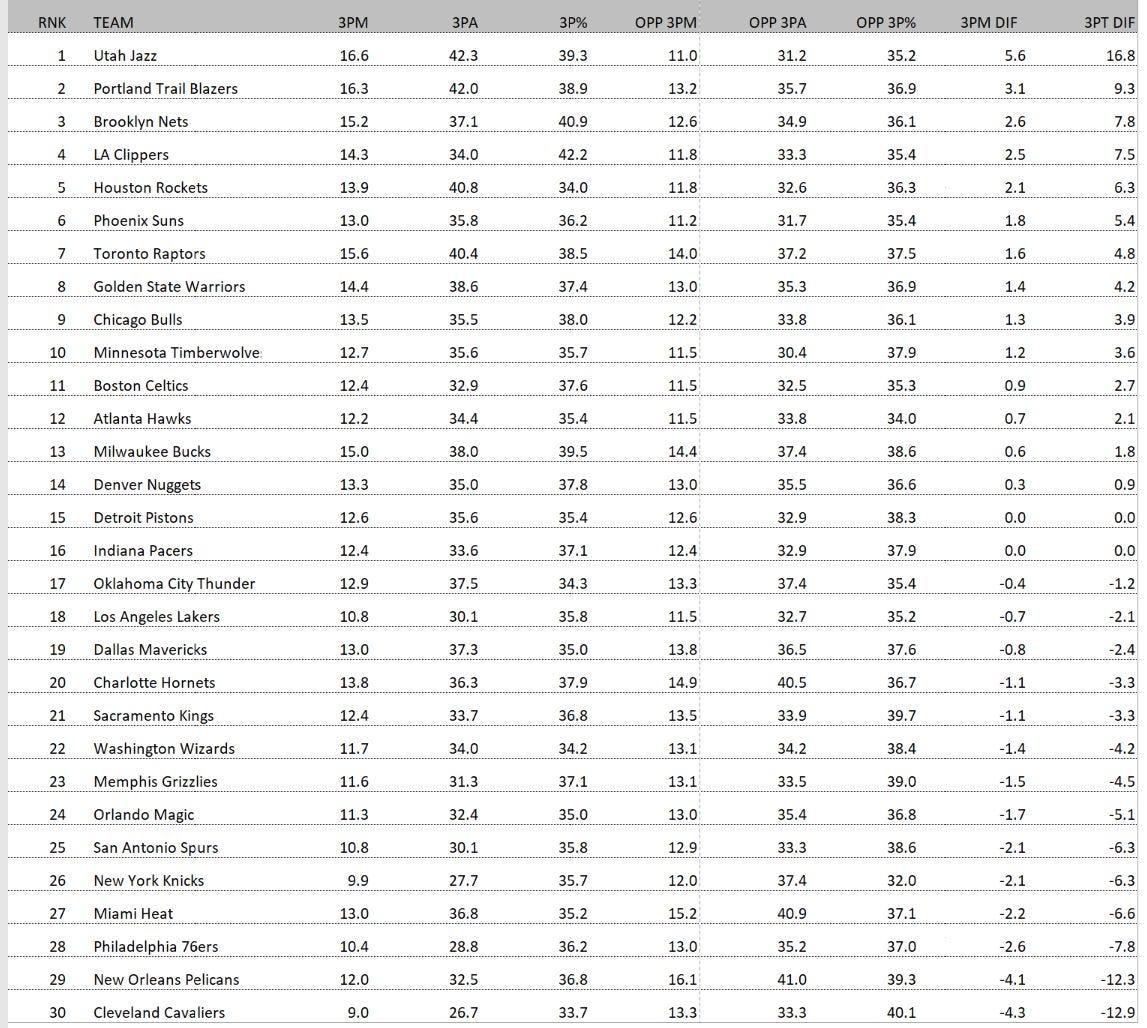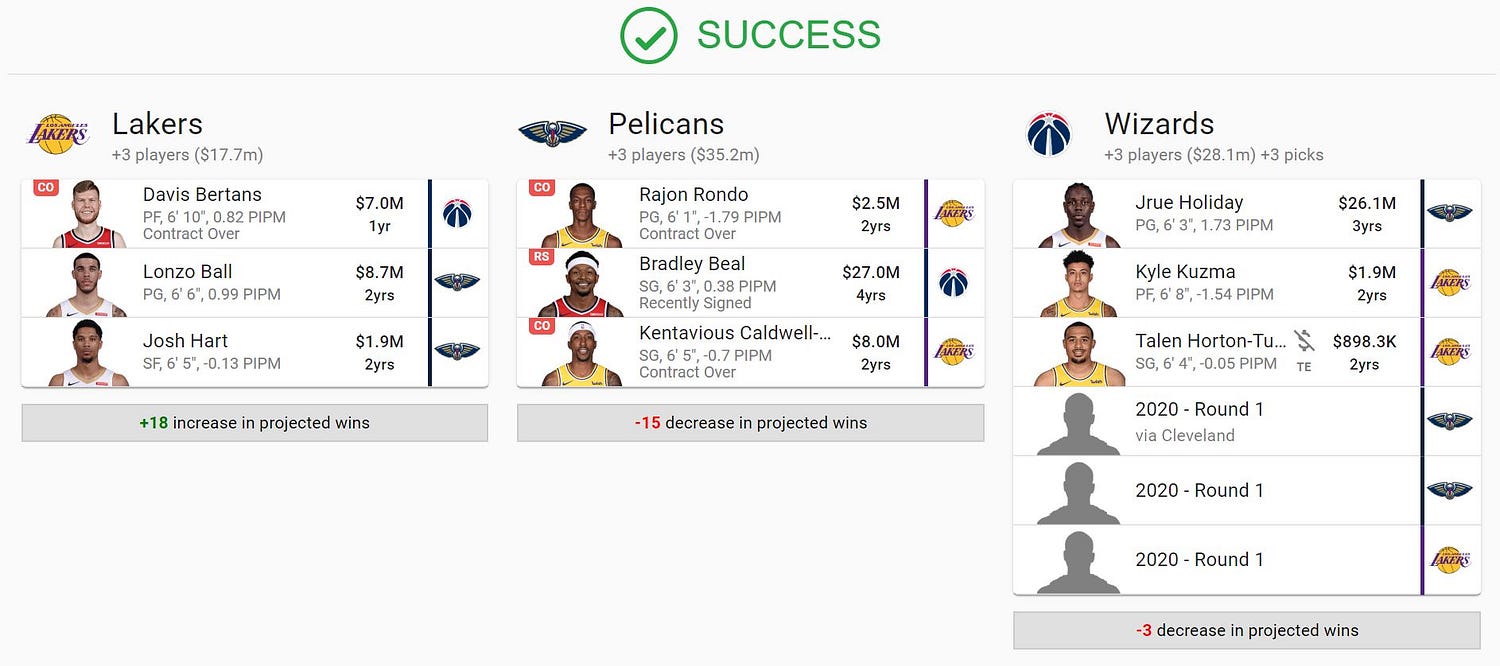There’s little doubt the Los Angeles Lakers’ Achilles heel on offense is their 3-point shooting. Despite a second best 22–9 record, the Lakers rank 26th in 3-point makes, 26th in 3-point takes, and 20th in 3-point percentage.
The only thing that’s saved the Lakers’ season from disaster is their top ranked defense, which has held their opponents to a league 4th fewest 3-point makes, 6th fewest 3-point takes, and 4th lowest 3-point percentage. Their elite 3-point defense has enabled them to win 11 of the 13 games where they made more than 10 threes, 3 of the 5 games where they made 10 threes, and 8 of the 13 games where they made less than 10 threes.
At the heart of the Lakers 3-point shooting problems is a lack of players who take and make a high volume of threes. Realistically, a team cannot create a 3-point differential unless it takes and makes more threes than it allows. The Utah Jazz, for example, take 10.8 and make 5.5 more threes than they allow. The Lakers, on the other hand, essentially just barely tread water, taking 2.1 and making 0.6 fewer threes per game than their opponents.
The reality is there isn’t room for the Lakers to fix their 3-point differential by improving their already excellent 3-point defense. Nor is simply shooting a higher percentage the answer. The only solution is to shoot more threes. Last night, they made a valiant effort to do exactly that, tying a season high 45 3-point attempts. The problem was they only made 13 of their threes for 28.9%, including a dismal 1 for 13 in the fourth quarter in a 96–94 loss.
The blueprint for winning with LeBron James has always been to surround him with high percentage, high volume 3-point shooters, Despite winning the championship last season, the Laker have failed to follow that blueprint. This season, the highest volume 3-point shooter on the Lakers is James himself, who’s 34th in the league at 6.7 threes per game. The next highest volume 3-point shooter is Kyle Kuzma, who’s 95th at 4.8 threes per game.
The Lakers’ 3-point shooting problems have unfortunately reached a panic level. Over the last 10 games, their 3-point shooting has just bottomed out, averaging only 8.7 makes out of just 29.8 takes for a league worst 29.2%. The time has come for Rob Pelinka and the Lakers’ front office to admit their lack of high percentage, high volume 3-point shooting has become the single biggest threat to the team’s hopes of repeating as NBA champions.
The Lakers need to prioritize trading for one or two quality high volume 3-point shooters who take more than 7 threes per game so they can increase the number of threes the team takes from 30.5 to the high 30’s per game. That should be Rob Pelinka’s primary focus over the next month. Trading for quality high volume 3-point shooters will be expensive but it’s the single biggest move the Lakers can make to improve their chances of repeating.
With that in mind, here are four proposed trades the Lakers could pursue before the March 24 trade deadline to upgrade the team’s offense with proven high percentage 3-point shooters who take 7 or 8 threes per game:
1. SCHRODER & CALDWELL-POPE FOR BALL & REDICK

This is a win-now gamble as the Lakers give up their low 3-point volume starting backcourt of Schroder and Caldwell-Pope for a controversial pair of high percentage, high volume 3-point shooters in Lonzo Ball and JJ Redick.
Ball has made 72 of 189 3-point shots this season for 38.1% while Redick has made 43 of 117 3-point shots for 36.8%. In contrast, Schroder has made 28 of 90 threes for 31.1% while KCP has made 40 of 97 threes for 41.2%. Ball and Redick in 25 games combined for 47 more made threes and 141 more points than Schroder and Caldwell-Pope. The trade would increase Lakers’ 3-point takes by 4.8, makes by 1.9, and points by 5.7 per game.
That’s exactly the kind of high volume 3-point production the Lakers need. The 22-year old 3&D Ball would immediately replace Schroder in the Lakers’ starting lineup while the 36-year old Redick would be a reserve. While Redick would provide short-term instant offense of the bench, the key to the trade is the controversial Ball, whose volume threes, defensive versatility, and elite outlet passing would be elite fits with Lebron and AD.
The trade would also be a win for the Pelicans, who’ve already committed to moving on from Ball and Ridick, as Schroder and Caldwell-Pope would be perfect complements alongside Brandon Ingram and Zion Williamson.
2. SCHRODER, KCP, & HARRELL FOR LOWRY & BAYNES

This is another win-now trade where the Lakers cash in a trio of proven young players in Schroder, Caldwell-Pope, and Harrell for 34-year old All-Star point guard Kyle Lowry and 34-year old stretch center Aron Baynes.
Lowry has made 69 of 178 3-point shots this season for 38.8% while Baynes has struggled and only made 12 of 56 threes for 21.4% with Toronto this year. But Baynes has potential and the hope is he can shoot like last season. Playing for the Suns last year, Baynes had a career season and made 59 of 168 threes for 35.1%. A change in scenery could be what Baynes needs to become the modern stretch five the Lakers need to fill their center rotation.
Lowry and Baynes volume 3-point shooting could theoretically combine for 11.1 takes, 4.2 makes, and 12.6 points per game, almost double the 6.9 takes, 2.6 makes, and 7.8 points from Schroder, Caldwell-Pope, and Harrell. Like the trade for Ball and Redick, the trade for Lowry and Baynes increase Lakers’ 3-point takes by 4.2, makes by 1.6, and points by 4.8 per game, which is exactly the kind of volume 3-point shooting the Lakers need.
Lowry would immediately replace Schroder as the Lakers’ starting point guard and give the Lakers the third star to complement LeBron and AD while Baynes would replace Harrell coming off the bench as a stretch five. Like Ball , Lowry is the key to the trade. He’s having a great season and still looks like he could play at that level for another couple of seasons. If Baynes could return to last year’s form, he would be a perfect backup center.
The trade would also be a win for the Raptors, who’ve already talked about moving Lowry and Baynes, as Schroder, Caldwell-Pope, and Harrell would rejuvenate them three talented young players to enable them to compete.
3. HORTON-TUCKER FOR GRAHAM

The is another win-now trade where the Lakers give up 20-year old budding superstar Horton-Tucker in exchange for young high volume 25-year old point guard Graham who takes over 8 threes per game and shoots 34.7%.
A 3-year veteran, Devonte has made 70 of 202 threes this season for 34.7%. He is the 11th most prolific 3-point shooter in the league and is averaging 13.7 points, 3.0 rebounds, and 5.7 assists in 32.8 minutes per game. Graham takes 8.1 and makes 2.8 threes per game for 8.4 points. Horton-Tucker takes 1.8 and makes 0.5 threes per game. The trade would increase the Lakers’ 3-point takes by 6.3, makes by 2.3, and points by 6.9 per game.
Devonte Graham would immediately move into the starting point guard role with Dennis Schroder coming off the bench like he did in OKC or share starting point guard duties with Schroder in a double point guard scheme. Either way, Graham would give the Lakers needed volume 3-point shooting and a legitimate second point guard to reduce the playmaking load off of LeBron James and upgrade the team’s overall playmaking and shooting.
With LaMelo Ball now the Hornets’ point guard of the future Terry Rozier enjoying a career season, the Hornets can afford to move Devonte Graham to land a potential future superstar in 20-year old Talen Horton-Tucker.
4. CALDWELL-POPE & HORTON-TUCKER FOR BEASLEY

This is a win-now trade where the Lakers give up 28-year old proven vet Caldwell-Pope and 20-year old future star Horton-Tucker for 24-year old Beasley, a young high volume shooter who takes almost 9 threes per game.
Malik Beasley has made 106 of 260 3-point shots this season for 39.6%. In contrast, the veteran Caldwell-Pope has made 43 of 102 threes for 42.2% while the second year Horton-Tayler has made 13 of 48 threes for 27.1%. Beasley takes 8.7 and makes 3.4 threes per game for 10.2 points. KCP and THT take 5.6 and make 2.1 threes per game. The trade would increase the Lakers’ 3-point takes by 3.1, makes by 1.3, and points by 3.9 per game.
Beasley would immediately replace Caldwell-Pope as the Lakers’ starting shooting guard, giving the Lakers the high percentage, high volume 3-point shooter they need to stretch defenses and create spacing for LeBron and AD. While stats on winning and losing teams aren’t comparable, Beasley’s 20.7 points, 4.9 rebounds, 2.5 assists in 32.8 minutes per game would be an upgrade over KCP’s 8.6 points, 2.2 rebounds, 1.4 assists in 25.6 minutes.
The Timberwolves give up a great young player in Bealey but receive a championship proven young vet in KCP and a future superstar in the uber talented Horton-Tucker who would likely be a Lakers’ starter next season.

